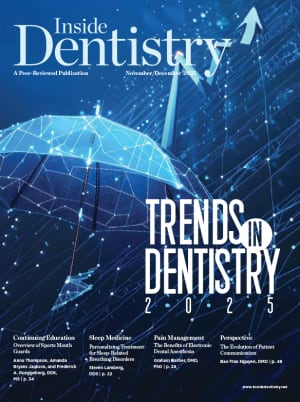Evaluating Bioactive Restorative Materials
Recent evidence and clinical implications
As restorative dentistry continues to evolve, the ongoing development of bioactive materials is offering new possibilities in tooth repair. Unlike traditional materials, bioactive materials not only restore damaged teeth but also promote remineralization and protect against future demineralization. This article explores some of the scientific principles behind bioactive restorative materials and highlights clinical implications based on recent evidence from a scoping review by do Nascimento Santos and colleagues.1
What Are Bioactive Restorative Materials?
Bioactive restorative materials are materials that interact with dental tissues in a biologically beneficial way, promoting remineralization or other favorable biological responses. Composed of additives such as bioactive glass, hydroxyapatite, and other mineral compounds, these materials have the ability to form an apatite layer on hard-tissue surfaces. This layer supports the restoration of tooth structure by releasing therapeutic ions that contribute to remineralization, which makes them an attractive option for modern restorative procedures. However, it is important to note that the term “bioactive” is sometimes used inconsistently in commercial contexts. Some materials marketed as bioactive may not meet rigorous scientific definitions, and clinicians should assess these claims carefully.
Key Bioactive Additives and Their Benefits
The most commonly used bioactive additives in restorative materials are bioactive glass and hydroxyapatite. These substances play critical roles in the remineralization process, especially for dentin and enamel. By promoting the formation of an apatite layer, these additives help neutralize acidic environments in the oral cavity, thus reducing the risk of demineralization. Their bioactive properties also encourage better bonding between the restorative material and the natural tooth structure, which contributes to a more durable, long-lasting restoration. In addition, the localized release of calcium and phosphate ions may support the healing of demineralized tissues.
Evidence of Bioactivity in Restorative Materials
Recent findings from a scoping review reveal that bioactive restorative materials, particularly those incorporating bioactive glass and hydroxyapatite, show promising results in in vitro studies.1 These materials have demonstrated the ability to form an apatite layer on hard dental tissues and release therapeutic ions that promote remineralization. However, despite these encouraging laboratory results, the clinical evidence remains limited. There is a need for more robust, long-term studies to confirm the real-world effectiveness of these materials and evaluate their impact on patient outcomes. Furthermore, few products have been tested in randomized controlled trials or head-to-head comparisons with conventional materials.
Challenges and Limitations
Although bioactive materials show considerable promise, there are challenges regarding their clinical application. A lack of standardized testing methods for bioactivity and inconsistent protocols for evaluating remineralization make it difficult to compare products or draw firm conclusions. Moreover, the long-term performance of bioactive restorative materials—particularly in terms of durability, wear resistance, and bond strength—has not been conclusively established in clinical settings. Most of the available evidence remains laboratory-based, which highlights the need for well-designed, long-term clinical trials. These limitations underscore the importance of ongoing research to validate claims and guide the integration of bioactive materials into routine clinical practice.
Clinical Implications for Restorative Dentistry
For clinicians, bioactive restorative materials offer a unique advantage, particularly when both restoration and remineralization are necessary. These materials are especially valuable in direct and indirect restorations, where their bioactive properties can enhance the interaction between the restoration and the tooth, improving both bond strength and longevity. Furthermore, bioactive materials can be beneficial in cases of early-stage dental decay, where they help prevent further damage and promote tooth repair. Their use may also be indicated in high-caries-risk patients, for cervical lesions, or when enhanced biocompatibility is desired. Until more clinical data is available, practitioners should consider these materials as adjuncts rather than replacements for conventional options.
An Increasingly Important Role
Bioactive restorative materials represent a significant advancement in restorative dentistry. With the potential to provide not only structural restoration but also biologic support for dental tissues, these materials are poised to enhance the way restorative procedures are performed. However, further clinical studies are needed to confirm their long-term benefits and establish best practices for their implementation in everyday clinical settings. As research continues and definitions become more standardized, bioactive materials are expected to play an increasingly important role in evidence-based dental care.
About the Author
Gabriela de AlencarPinto Magalhães, DDS, MSc, PhD
Assistant Professor
Department of Restorative Sciences
Dental College of Georgia
Augusta University
Augusta, Georgia
Rafael Rocha Pacheco, DDS, MSc, PhD
Associate Dean for Digital Technologies
Associate Professor
Department of Restorative Sciences
Dental College of Georgia
Augusta University
Augusta, Georgia
Reference
1. do Nascimento Santos JV, Magalhães GAP, Costa Leite JV, et al. From names to concepts: unraveling bioactivity in restorative dental materials. J Am Dent Assoc. 2025;156(5):355-373.e2.
